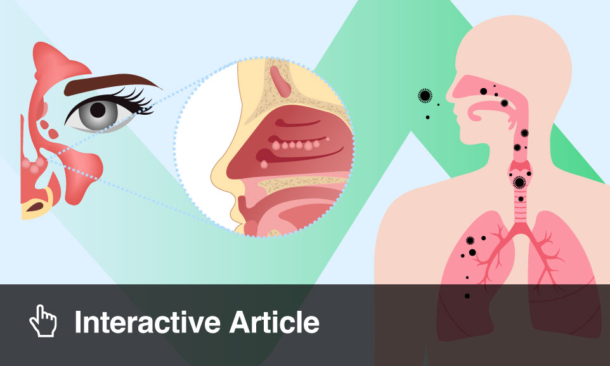Interview Summary
Hereditary angioedema (HAE) attacks can be debilitating and potentially life-threatening, particularly when they affect the abdomen or airways. Recently targeted prophylactic medications have been developed and licensed and treatment practices have evolved. Long-term prophylaxis (LTP) is recommended in international guidelines to reduce attack frequency and improve quality of life (QoL) for patients. EMJ spoke to HAE experts Isabelle Boccon-Gibod and Sorena Kiani about their clinical experience of treating patients with HAE and with first-line prophylaxis, in particular oral berotralstat. In clinical trials, berotralstat has been shown to reduce attack rates by over 90% and improve patient-reported outcomes, including reduced symptom severity. Real-world data further supports its long-term effectiveness and tolerability, although some patients discontinue medication due to adverse effects or insufficient efficacy. Boccon-Gibod and Kiani emphasised the importance of shared decision making between healthcare professionals and patients with HAE when choosing LTP treatments, and explained that patients are more likely to continue with their medication and be able to normalise their lives when they feel supported and are well-informed about medications and potential side-effects. Regular follow-ups and education, along with addressing potential side effects, are crucial to ensuring treatment success.
INTRODUCTION
Hereditary angioedema (HAE) is a rare genetic condition that affects approximately one in 50,000 people worldwide.1 It is characterised by unpredictable episodes of cutaneous or submucosal oedema in different parts of the body, which can be life-threatening when affecting the upper respiratory tract.1
Most cases of HAE are caused by mutations in the SERPING1 gene that encodes the C1-esterase inhibitor (C1-INH) protein.2 The mutations result in a reduction or dysfunction in C1-INH protein.2 This affects the kinin-kallikrein pathway, resulting in overproduction of bradykinin and increased vascular permeability, ultimately causing angioedema.2 In some cases, however, patients experience angioedema attacks despite having normal levels and function of C1-INH (nC1-INH) and an absence of mutation in genes coding for C1-INH.3 In these patients several mutations have been identified, including those affecting genes coding for Factor XII (FXII), plasminogen (PLG), or kininogen (KNG1).3,4,5
Understanding the underlying causes of angioedema has led to the development of specific drugs that are effective in treating acute HAE attacks and reducing the risk of attacks.
International guidelines1 now recommend three licenced long-term prophylactic treatments for HAE.1 One is plasma-derived C1-INH that replaces the deficient C1-INH protein. The other two are berotralstat and lanadelumab, molecules that inhibit the kallikrein production pathway.1 All three licensed LTPs have been shown to significantly reduce the number of HAE attacks.1 Two of them are administered parenterally, and the third, berotralstat, is taken orally in capsule form.
EMJ spoke to two HAE physicians, Isabelle Boccon-Gibod, Immunologist and Allergologist, Université Grenoble Alpes, France, and Sorena Kiani, Clinical Immunologist, Royal Free NHS Foundation Trust, London, UK, to find out how LTPs are impacting the lives of people with HAE.
TRANSFORMING HEREDITARY ANGIOEDEMA PATIENT CARE WITH LONG-TERM PROPHYLACTICS
HAE attacks can be extremely painful or functionally disabling when affecting the abdomen or periphery and can be life-threatening if oedema develops in the upper airways.1
The 2021 International World Allergy Organization (WAO)/European Academy of Allergy and Clinical Immunology (EAACI) Guidelines for HAE management1 recommend long-term prophylaxis to reduce the risk of HAE attacks.1 Increasingly, patients with HAE throughout Europe and the USA are recommended LTPs to help manage their HAE. Prophylaxis that reduces HAE attacks helps improve quality of life (QoL) for patients by reducing anxiety and the fear that they might have an attack at any moment.
Kiani is clear that clinical practice has completely changed since the development of specific prophylaxis for HAE. “Patients need to be free of attacks and be able to conduct as normal a life as they can, but until recently, we didn’t have the tools available for it,” Kiani asserted. “Practice has changed because now we have licensed LTPs available, and we can consider prophylaxis for all eligible patients.”
The international guidelines for HAE management emphasise that LTP recommendations should be individualised and take into consideration factors including disease activity, patient’s QoL, availability of health care resources, and patient preferences.1 Kiani went on to explain that in the UK, a patient who has two attacks per month or more is eligible for LTPs, and the different options provide a choice for patients. “Having an oral option available means patients who don’t want an injection can benefit from that.”
In Boccon-Gibod’s clinics in France, they recommend LTP and discuss the possible options with any patient who experiences more than five severe attacks per year or one attack per month. In addition, they explained: “If the patient feels that their quality of life is impaired, regardless of the severity or location of the attacks, we recommend LTPs.”
“The purpose of the LTP treatment is to improve quality of life,” Boccon-Gibod emphasised. “Through our therapeutic programme6 involving discussions with the patient, we ensure that the treatment is understood and that the patient will adhere to it.”
Kiani summarised how practice has changed in recent years. “We can now use targeted medications, and we are looking towards normalising patients’ lives. Patients can hope to have no attacks. In addition, we have several options available.” So, if one medication does not work or is not tolerated well, or the patient prefers a particular regimen or delivery route, there are other options.
IMPACT OF BEROTRALSTAT ON ATTACK RATE AND PATIENT-REPORTED OUTCOMES: FROM CLINICAL TRIALS TO REAL-WORLD PRACTICE
The APeX-2, double-blind clinical trial demonstrated that long-term prophylaxis with berotralstat (150 mg daily) was effective in reducing HAE attack rates and provided clinically meaningful improvements in QoL.7-9
Long-term analysis of the APeX-2 trial demonstrated that mean attack rate was reduced by more than 90% from baseline in patients who completed 96 weeks of 150 mg/day berotralstat. During the second year of the study, patients across all treatment groups were attack free for 93.1% of the days and the medication was generally well tolerated.10,11 Berotralstat was effective in reducing HAE attack rates regardless of how many attacks patients experienced before treatment or if they had experience with a prior LTP. In an analysis from APeX-S, the percentage of attack-free days remained at 92% or above for all subgroups of patients (grouped according to age, gender, or previous use of prophylaxis) over 96 weeks.11,12
But how does berotralstat perform outside of clinical trials where adherence to medication can become an issue? Increasingly real-world data is becoming available that supports the tolerability and effectiveness of berotralstat. For example, the BeroLife study, an observational study of 64 patients across 18 centres in France, demonstrated that after 12 months of follow-up, berotralstat led to a reduction in attacks, was generally well tolerated, and safety was consistent with what was observed in clinical trials.13
A survey carried out on a cohort of patients taking berotralstat in the UK provided the first real-world evidence that berotralstat supports better patient-reported outcomes using the Angioedema Control Test (AECT).14 Fifty-four out of 100 patients responded to the survey, and the mixed-method analysis showed significant improvement in patient-reported outcome measures, including symptom severity scores, compared to 3 months prior to the start of treatment.14
This is further reflected in a small study of the early experience of berotralstat use in six patients with nC1-INH HAE.15 Boccon-Gibod explained that there is a reduction in the severity of attacks and the patients are enjoying an improved QoL.15
“The number of attacks is not always the reason for suggesting LTP to the patient,” Boccon-Gibod reiterated. “Patients may have only a limited number of attacks, but these may have a significant impact on their daily lives. Berotralstat can be beneficial in these cases and our prescribing recommendations are in line with that.”
The unpredictability of HAE attacks has a major impact on patients’ QoL. “You could be anywhere, and it might be difficult for you to manage the attack. For example, because you cannot access your acute medication. Alternatively, you may have a disability, or it might be psychologically difficult for you to administer medication yourself,” Boccon-Gibod explained.
Suitability of Berotralstat for Patients with Hereditary Angioedema
At each clinic visit, Boccon-Gibod and Kiani discuss with patients their needs and aspirations for treatment, and the potential advantages and disadvantages of each licensed LTP. Shared decision-making between patient and physician is key for treatment success and to achieve the goal of normalising patients’ lives.
Boccon-Gibod explained that it is important for the patient’s confidence that they understand their medication regimen and that it will be reviewed regularly. “The patient needs to know that they won’t necessarily be taking that particular medication for life,” Boccon-Gibod added.
It is clear from clinical trials and real-world data that patients with HAE can benefit from berotralstat regardless of their baseline attack rate and severity,16,17 and this is reflected in Kiani and Boccon-Gibod’s clinical practice.
“In England, if patients have two or more attacks per month, berotralstat can be prescribed. If they are having eight or more attacks per month despite an adequate trial of berotralstat, we have a conversation about which injectable medication they prefer, either subcutaneous lanadelumab every 2 weeks, moving to once a month in some cases, or C1 esterase inhibitor replacement by slow intravenous infusion over 10 minutes twice a week,” Kiani explained.
Boccon-Gibod added: “In our experience, for patients who have normal C1-INH levels but experience HAE attacks, the efficacy of berotralstat treatment is comparable with that seen in patients with deficiency in C1-INH.”15
According to Kiani, based on their real-world experience, most patients respond to treatment with berotralstat, but it is difficult to predict who will benefit most, based on the severity or frequency of their attacks prior to treatment.
“Some patients report mild adverse drug reactions, largely GI in nature, when taking berotralstat,18,19 but the symptoms usually only last a few days or weeks,” Kiani explained. “A few patients reported loose stools shortly after taking the medication initially, but not severe diarrhoea.” With reassurance and support from healthcare providers, these patients were happy to continue taking the medication. “Other people do well and don’t have any adverse events and continue to benefit over several years,” Kiani added.
According to Kiani, an important group of people who would benefit from taking a targeted drug, licensed on the basis of rigorous clinical trials, are patients who are currently taking attenuated androgens (AA).
“It is important that we encourage these patients to transition to first-line prophylactics due to the known long-term side effects of AAs, including virilization, depression, poor sleep, and increased risk of cardiovascular disease. I see this as my responsibility, to explore if patients have these side effects,” emphasises Kiani.
Although there are no data to indicate that any particular subgroups of patients might benefit more from oral berotralstat, in Boccon-Gibod’s opinion, patients who experience a moderate number of attacks are good candidates for berotralstat. “Perhaps teenagers are also good candidates because, in my experience, they don’t like injectables,” Boccon-Gibod continued. Berotralstat is currently approved for use in children aged 12 or older.20 In these older children with HAE, “Treatment is the same as for adults, with LTP [recommended] when attacks are frequent, and quality of life is impaired,” explained Boccon-Gibod. Prophylaxis reduces the need for injectable, on-demand treatment, and it tends to be more readily accepted by children compared to adults. Kiani agreed, saying: “Children who have been diagnosed correctly [with HAE] still have to put up with the burden of injectable treatment which they may find very uncomfortable.” However, Boccon-Gibod added, “This is likely to change with the future new oral treatment for attacks that are being developed.”
Kiani also pointed out that there are reports of some adults switching from first-line injectable prophylactics because they are not benefiting, or they find an injectable inconvenient.21 Kiani added, “There is an argument that in theory, two medications working on the same target should both work in a patient. However, differences are apparent, and it is hard to predict who will do better with an oral small molecule drug or an injectable one.”
ADHERENCE AND COMPLIANCE
Most patients find berotralstat effective in reducing the number and/or severity of HAE attacks.8 However, some patients do discontinue treatment.
According to Boccon-Gibod, some patients discontinue medication because they experience side effects or insufficient efficacy, but they added, “Usually patients try for a while to be sure it is not a temporary situation, and it doesn’t happen often.”14
An interim analysis of 56 patients from the ongoing multicentre, observational safety study, APeX-N PASS,19 found that from the time of study consent, 12.5% of patients receiving berotralstat experienced non-serious gastrointestinal adverse drug reactions.20 These included diarrhoea (n=4), abdominal distension (n=3), nausea (n=2), dyspepsia (n=1), constipation (n=1), and abdominal pain (n=1).19 Very few patients (four; 7.1%) discontinued treatment due to unsatisfactory response or to participate in other investigational clinical trials.19
“If people are prepared for the possible side effects, then they seem to adhere for longer and stay on the medication,” commented Kiani, who went on to point out that compliance and adherence to medication are important areas for debate that go beyond HAE. “In general, people are not always very compliant,” they said. “When people are feeling well, many patients often stop taking their medications.”
Kiani addresses this in their clinics by encouraging open and honest discussions with patients. “I normally start by saying, ‘Many people miss their medications sometimes. How many days a week do you manage to take your medications?’” Most people miss a dose here and there, and some people prefer not to say. “If they start to have attacks, we explore why they are missing doses. Some people just forget.”
Boccon-Gibod and Kiani agree that explaining to patients the chances of getting side effects is important, and also that some people might not benefit from a particular medication.
“When we first started looking at real-world data, some units had high levels of discontinuations. When we explored it, we found that in some units, patients were not receiving the necessary level of support given by specialist nurses in other UK units,” Kiani explained.
“With my current patient cohort, we give them an email address so they can contact us with any questions.” This is reflected in Boccon-Gibod’s practice, where patients have 24/7 access to specialist support via a telephone hotline.
Both Kiani and Boccon-Gibod reiterated that it is important for patients to understand their treatment. “With our therapeutic programme, we have education nurses who regularly follow up with patients. At the start of a new treatment the patient knows who to contact at the centre,” Boccon-Gibod said.
“In addition, in France, for patients taking berotralstat, we have an industry-sponsored, pharmacist-led follow-up service to check in with patients on compliance. Patients collect their monthly box of medication from the pharmacy and have a follow-up at the same time.”22
Boccon-Gibod outlined how they explain to patients that efficacy may be gradual and that they may initially have some gastrointestinal symptoms, which can be managed, in general, with proton-pump inhibitors. “We are really confident that we can manage these temporary side effects, and this helps to reassure patients.” Boccon-Gibod added that they have also developed a brochure that addresses the most frequently asked questions.
Kiani reiterated the importance of setting the right expectations with patients at the beginning of treatment through clear, open dialogue about temporary side effects and giving the medication enough time to show optimal effectiveness. “We ask patients to let us know if they have any side effects, and the gastrointestinal ones can usually be treated with proton-pump inhibitors or antacids. We also tell them that the medication probably won’t work at its best until about a week after they start taking the daily dose,” Kiani explained. “We don’t know the mechanisms resulting in side effects, but with time we hope to discover more patterns and find better ways to manage them.”
DEVELOPING BEST PRACTICE TO SUPPORT PROPHYLAXIS FOR HEREDITARY ANGIOEDEMA
LTPs are recommended in international treatment guidelines1 to reduce the risk of HAE attacks and improve patient QoL. QoL is paramount for patients with HAE, as Boccon-Gibod reiterated: “If a patient is experiencing more than five severe attacks per year, we aim to start LTP as soon as possible.” In France, the choice is an anti-kallikrein treatment, either orally with berotralstat or as an injectable. In the UK, there are three options, and as Kiani said, they are considered equally during discussions with patients as long as they qualify.
“We explain to the patient that being able to tolerate the treatment is important, not only the efficacy of the LTP,” explained Boccon-Gibod. “We know that this is a priority for patients today.”
If the patient is on AAs, they are evaluated and, where possible, switched to first-line prophylactics. For anyone who is resistant to transitioning away from AAs, Boccon-Gibod explains to them at each clinic visit the cardiovascular risks of AAs and other side effects associated with the long-term use of androgens. “It is very important with our therapeutic programme to take time to explain the risks of taking androgens. Without this time, patients are not sufficiently aware. We also explain that the new treatment is better for long-term prophylaxis,“ continued Boccon-Gibod.
International networks of HAE experts exist to encourage best practice. Boccon-Gibod and colleagues have created a registry of patients with HAE in France. The CREAK network and the education programme for managing patients are publicised via ACARE and provide important resources for physicians worldwide. “We work in a network with other European countries and share data through the ACARE network across Europe and beyond,”23 Boccon-Gibod confirmed.
In all cases, it is important to maintain regular dialogue with patients to ensure the benefits of the treatment continue and to monitor any adjustments in the long-term management of the disease.
CONCLUSION
Delivering Better Quality of Life for People with Hereditary Angioedema
Berotralstat is the first oral medication licensed as an LTP to treat HAE. “It has been a major advance for people with HAE,” said Boccon-Gibod. “We have been waiting a long time for an oral treatment to reduce HAE attacks. With the arrival of anti-kallikreins, patients’ lives have changed dramatically, and it is a real comfort for many people not to have to inject medication. Patients experience fewer attacks, and this helps them worry less about how the disease might affect their daily life.”
Kiani agreed, saying: “Berotralstat has been a useful addition to the medications we have to treat HAE. It really has made a difference to the work we do in the clinic to control and manage HAE and to improve patients’ quality of life, particularly for those having multiple attacks and not wanting to use acute medication.”
“Once a patient has had a few months without any attacks, they really start believing that the medication is working, and this gives them the confidence they need to lead a more normal life,” Kiani concluded.
| Adverse events should be reported. Reporting forms and information for the United Kingdom can be found at www.mhra.gov.uk/yellowcard or search for MHRA Yellow Card in the Google Play or Apple App Store. Adverse events should also be reported to BioCryst UK Ltd on +44 (0)203 8850789 or email [email protected]. |
UK.HAE.00249
May 2025





